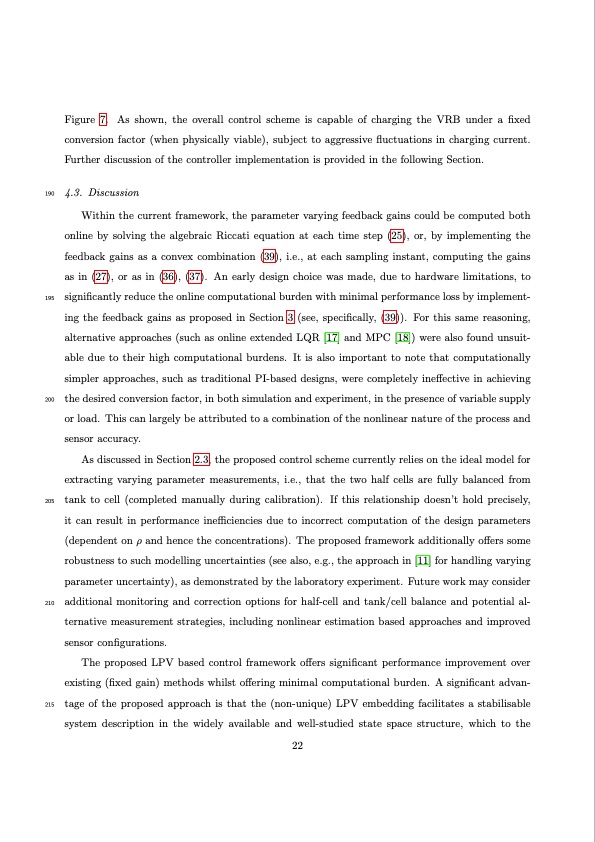
PDF Publication Title:
Text from PDF Page: 022
Figure 7. As shown, the overall control scheme is capable of charging the VRB under a fixed conversion factor (when physically viable), subject to aggressive fluctuations in charging current. Further discussion of the controller implementation is provided in the following Section. 190 4.3. Discussion Within the current framework, the parameter varying feedback gains could be computed both online by solving the algebraic Riccati equation at each time step (25), or, by implementing the feedback gains as a convex combination (39), i.e., at each sampling instant, computing the gains as in (27), or as in (36), (37). An early design choice was made, due to hardware limitations, to 195 significantly reduce the online computational burden with minimal performance loss by implement- ing the feedback gains as proposed in Section 3 (see, specifically, (39)). For this same reasoning, alternative approaches (such as online extended LQR [17] and MPC [18]) were also found unsuit- able due to their high computational burdens. It is also important to note that computationally simpler approaches, such as traditional PI-based designs, were completely ineffective in achieving 200 the desired conversion factor, in both simulation and experiment, in the presence of variable supply or load. This can largely be attributed to a combination of the nonlinear nature of the process and sensor accuracy. As discussed in Section 2.3, the proposed control scheme currently relies on the ideal model for extracting varying parameter measurements, i.e., that the two half cells are fully balanced from 205 tank to cell (completed manually during calibration). If this relationship doesn’t hold precisely, it can result in performance inefficiencies due to incorrect computation of the design parameters (dependent on ρ and hence the concentrations). The proposed framework additionally offers some robustness to such modelling uncertainties (see also, e.g., the approach in [11] for handling varying parameter uncertainty), as demonstrated by the laboratory experiment. Future work may consider 210 additional monitoring and correction options for half-cell and tank/cell balance and potential al- ternative measurement strategies, including nonlinear estimation based approaches and improved sensor configurations. The proposed LPV based control framework offers significant performance improvement over existing (fixed gain) methods whilst offering minimal computational burden. A significant advan- 215 tage of the proposed approach is that the (non-unique) LPV embedding facilitates a stabilisable system description in the widely available and well-studied state space structure, which to the 22PDF Image | Electrolyte Flow Rate Control Vanadium Redox Flow Batteries

PDF Search Title:
Electrolyte Flow Rate Control Vanadium Redox Flow BatteriesOriginal File Name Searched:
2201-12812.pdfDIY PDF Search: Google It | Yahoo | Bing
Salgenx Redox Flow Battery Technology: Salt water flow battery technology with low cost and great energy density that can be used for power storage and thermal storage. Let us de-risk your production using our license. Our aqueous flow battery is less cost than Tesla Megapack and available faster. Redox flow battery. No membrane needed like with Vanadium, or Bromine. Salgenx flow battery
| CONTACT TEL: 608-238-6001 Email: greg@salgenx.com | RSS | AMP |